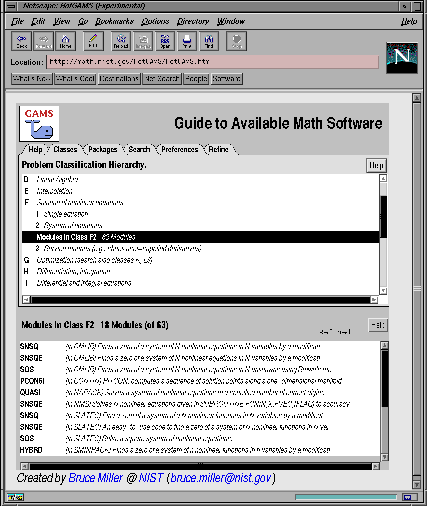
Table: Number of GAMS Users Per Month (1995-96)
A wealth of reusable software is currently available to scientists and engineers for solving recurring mathematical and statistical problems. Unfortunately, the volume of this software and its distribution over labyrinthine computer networks has made it difficult for the average user to locate appropriate tools. The Guide to Available Mathematical Software (GAMS ) project develops techniques and tools to help scientists and engineers locate and use such software. Products of this work include a taxonomy of mathematical and statistical problems, a database of information about available software, and information systems which give users access to it.
The GAMS system serves as both a cross-index and a virtual repository for mathematical software. As a cross-index it currently provides information about 9,866 software modules from 98 packages available from four repositories, including netlib. This encompasses research software developed at NIST, commercial software supported for use on internal NIST systems, and research software developed in the external numerical analysis community. This information is indexed using the GAMS Classification System, which has become a de facto standard for classifying mathematical software, having been adopted by many commercial software vendors and scientific computing installations worldwide. GAMS also provides centralized access to such items as abstracts, documentation, and source code of software that it catalogs. GAMS is a virtual repository in that most of these items are retrieved on demand from Internet-accessible repositories operated by others.
We support the following network servers.
These services are provided on the host math.nist.gov, a Sun SPARC 10 Model 51 workstation with 96 Mbytes of main memory and a 1 Gbyte hard disk, purchased in 1993 with a Department of Commerce Pioneer Fund grant. This server also provides a home to the following Weblets.
This year took a number of steps to help improve the GAMS service, including:
Measuring Impact The GAMS system was made available to the public in March 1994, and the system has processed more than 2,000,000 Web transactions since that time. Table 2 shows the number of users each month, measured as the number of WWW home page retrievals plus native GAMS client registration transactions. The breakdown of GAMS users by Internet domain for May 1996 is given in Table 3.

Table: Number of GAMS Users Per Month (1995-96)

Table: GAMS Users by Internet Domain for May 1996
A number of additional external indicators of the success of the GAMS project have been realized this year, including the following.
GAMS provides a significant point-of-contact between ACMD and US commercial enterprises. GAMS was accessed from computers of 2,206 US commercial enterprises from January 1995 through May 1996 (identified by distinct subdomains of the .com Internet domain who made http server requests). Of companies, 1,926 searched the GAMS database, and 777 downloaded software components
In many cases cases commercial WWW service providers have provided explicit links to GAMS in their servers. Among these are
Current Research This year the GAMS project is receiving partial support from DARPA for joint work with Bell Laboratories (Eric Grosse) and the University of Tennessee at Knoxville (Jack Dongarra) for a project entitled Evolving Software Repositories . This support will allow us to upgrade the GAMS server and to explore the use of new technologies in support of software repositories like GAMS and netlib .
The first accomplishment is the prototype of HotGAMS! (see the figure below). HotGAMS! is a Java implementation of the GAMS client providing all of the functionality of the GAMS WWW interface, along with the several improvements.

Caption: HotGAMS! , a Java interface to GAMS.
In the coming year we plan to use HotGAMS! for research in new classification-based access mechanisms for software repositories.
(Other NIST staff who contributed to the GAMS project this year are Jeanne Springmann (888), Marjorie McClain, Frederick Boland (879) and William Mitchell.)